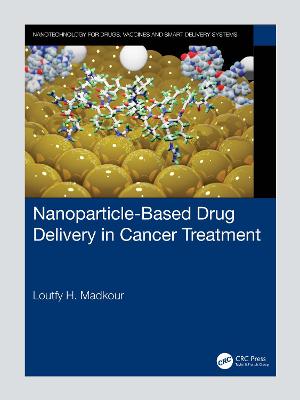Nanotechnology for Drugs, Vaccines and Smart Delivery Systems
2 total works
Nanoparticle-Based Drug Delivery in Cancer Treatment
by Loutfy H. Madkour
The careful choice of nanoparticles as targets and in drug delivery routes enhances therapeutic efficacy in cancer. Nanoparticle-Based Drug Delivery in Cancer Treatment discusses nanotechnological developments of interfering RNA-based nanoparticles, delivery vehicles, and validated therapeutic RNAi–molecular target interactions and explains the results of clinical and preclinical trials. The book also gives strategies for universal methods of constructing hybrid organic–inorganic nanomaterials that can be widely applied in the biomedical field.
Key Features:
- Reviews recent advances of nanoparticle-mediated siRNA delivery systems and their application in clinical trials for cancer therapy
- Focuses on material platforms that establish NPs and both localized and controlled gene silencing
- Emphasizes the most promising systems for clinical application
- Surveys progress in nanoparticle-based nanomedicine in cancer treatment
- Describes the most advanced of the nonviral nanocarriers for delivery of oligonucleotides to malignant blood cancer cells
This book is a valuable resource for researchers, professors, and students researching drug delivery, gene carriers, cancer therapy, nanotechnology, and nanomaterials.
This book presents an overview of the current status of translating the RNAi cancer therapeutics in the clinic, a brief description of the biological barriers in drug delivery, and the roles of imaging in aspects of administration route, systemic circulation, and cellular barriers for the clinical translation of RNAi cancer therapeutics, and with partial content for discussing the safety concerns. It then focuses on imaging-guided delivery of RNAi therapeutics in preclinical development, including the basic principles of different imaging modalities, and their advantages and limitations for biological imaging. With growing number of RNAi therapeutics entering the clinic, various imaging methods will play an important role in facilitating the translation of RNAi cancer therapeutics from bench to bedside. RNAi technique has become a powerful tool for basic research to selectively knock down gene expression in vitro and in vivo. Our scientific and industrial communities have started to develop RNAi therapeutics as the next class of drugs for treating a variety of genetic disorders, such as cancer and other diseases that are particularly hard to address with current treatment strategies.
Key Features
- Provides insight into the current advances and hurdles of RNAi therapeutics.
- Accelerates RNAi, miRNAs, and siRNA drug development for cancer therapy from bench to bedside.
- Addresses various modifications and novel delivery strategies for miRNAs, piRNAs and siRNA delivery in anticancer therapeutics.
- Explores the need for the interaction of hematologists,cell biologists, immunologists, and material scientists in the development of novel cancer therapies.
- Describes the current status of clinical trials related to miRNA and siRNA-based cancer therapy
- Presents remaining issues that need to be overcome to establish successful therapies.

